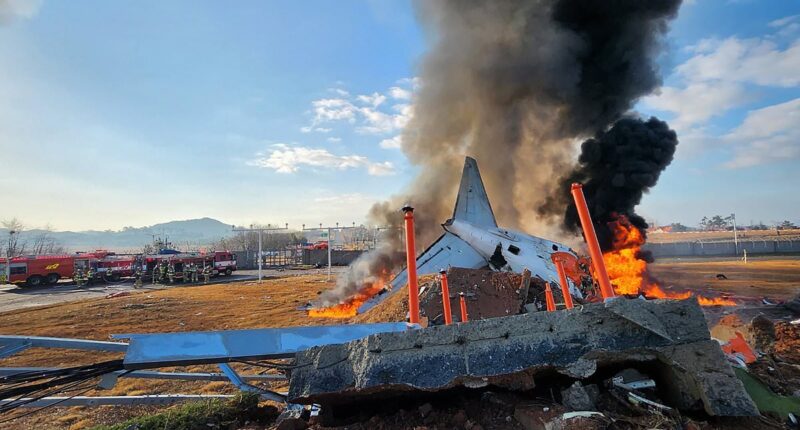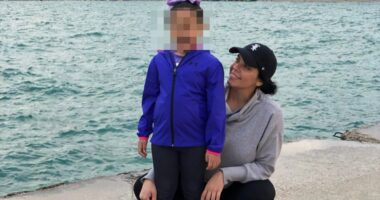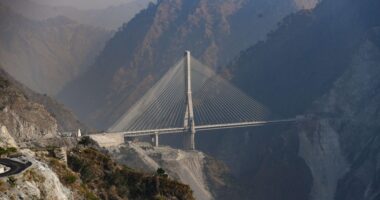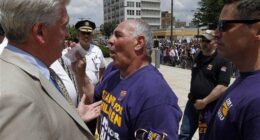
Aviation experts say a bird strike should not have crippled the landing gear of the doomed plane that crashed in South Korea and killed 179 people.
The Boeing 737-800, a plane with two engines, was carrying 181 passengers and is thought to have encountered a group of birds while trying to land at Muan International Airport on a Sunday morning.
There is video footage that has not been confirmed which supposedly captures the plane with flames coming out of its right engine, suggesting the moment a bird hit the aircraft.
Early theories had suggested it could have caused the budget airline’s jet’s landing gear to malfunction.
However, doubts have been expressed by experts, including Australian airline safety specialist Geoffrey Dell, who stated, ‘I have never witnessed a bird strike that prevented the landing gear from being lowered.’
Airline News editor Geoffrey Thomas said bird strikes happen ‘far more often, but typically they don’t cause the loss of an airplane by themselves’.
The doomed aircraft attempted a belly-landing before skidding off the 2,800-metre runway, ploughing into a concrete wall and bursting into flames.
All 175 passengers were killed on the flight from Thailand’s capital Bangkok, with four crew members among those dead in the deadliest air disaster on South Korean soil since 1997.
Miraculously, two of the flight crew – a 33-year-old male and a female – survived the horror crash and were pulled from the burning wreckage, before being taken to hospital with non-life-threatening injuries.
Mr Thomas questioned why fire tenders didn’t lay foam on the runway.
‘Why weren’t they in attendance when the plane touched down? And why did the aircraft touch down so far down the runway? And why was there a brick wall at the end of the runway?,’ he said.
‘A bird strike is not unusual, problems with an undercarriage are not unusual. Bird strikes happen far more often, but typically they don’t cause the loss of an airplane by themselves.’
Trevor Jensen, an Australian aviation consultant, said fire and emergency services would normally be ready for a belly-landing, ‘so this appears to be unplanned’.
However, aviation expert Sally Gethin told Sky News a bird strike could cause damage to the engine and the hydraulics to fail.
She said it was a ‘plausible explanation’ for causing a landing gear failure.
‘The pilots would have had to make very split-second decisions on what their options would be in a case like that,’ she said.
‘Then, of course, they ran out of runway and hit a buffer wall right at the end which caused the actual eruption.’
Marco Chan, a senior lecturer in aviation operations at Buckinghamshire New University, said the evidence suggested the plane had encountered a flock of birds ‘leading to suspected bird ingestion into the engines’.
‘Witnesses reported hearing explosions and seeing flames from the right-hand engine, indicating potential damage,’ he said.
‘This damage may have caused a hydraulic system failure, which could explain the inability to deploy the landing gear.’
He said the tight timeline between the bird strike warning and the pilot declaring Mayday meant it ‘likely constrained the crew’s ability to troubleshoot effectively and assess all options, including possible diversion to an alternate airport with a longer runway’.
‘The inability to deploy the landing gear forced the crew to attempt a belly landing on Muan’s 2,800-metre runway,’ he said.
‘The Boeing 737-800 is a reliable and widely used aircraft, and this crash appears to result from an unfortunate chain of events rather than a systemic design flaw.
‘The findings from the investigation will provide critical lessons for preventing similar tragedies in the future.
‘Our thoughts are with the family and friends of all crew and passengers on Jeju Air Flight 7C-2216, and the aviation industry must learn lessons from this tragic incident.’
Mr Chan added that ‘while a longer runway could have helped, it is not just about finding one – it’s about whether it’s safe and possible to get there’.
A spokesperson for Jeju Air was not immediately available for comment.
The company declined to comment on the cause of the accident during news conferences, saying an investigation is under way.
But according to the Yonhap news agency, the head of Jeju Air’s management team, Song Kyung-hoon, told a press briefing that the crash was not due to ‘any maintenance issues’.
Under global aviation rules, South Korea will lead a civil investigation into the crash and automatically involve the National Transportation Safety Board in the United States where the plane was designed and built.
The single-aisle aircraft was seen in video broadcast on local media skidding down the runway with no visible landing gear before slamming into a wall in an explosion of flame and debris.
A South Korean transport official earlier said that the plane had attempted to land but was told by the air traffic control to hold off after giving a bird strike warning.
Around two minutes later the pilot called a Mayday and was given permission to land from the opposite direction.
‘That gives you all the parameters of all the systems of the plane. The heartbeat of the airplane is on the flight data recorder,’ Mr Thomas said. ‘The voice recorder will probably provide the most interesting analysis of what went on on this tragic crash.’
Experts cautioned that air accidents are usually caused by a cocktail of factors and it can take months to piece together the sequence of events in and outside the plane.
In a televised news conference, the airline’s chief executive, Kim E-bae, gave a deep bow with other senior company officials as he apologised to bereaved families and said he feels ‘full responsibility’ for the incident.
He said the company had not identified any mechanical problems with the aircraft following regular checks and that he would wait for the results of government investigations into the cause of the incident.
Five children all aged under 10, including a three-year-old boy, are the youngest victims of the horror plane crash.
South Korea’s acting President Choi Sang-mok has declared a national mourning period until January 4.
Grieving families screamed and wept in the arrivals hall as the names of those confirmed dead were read out by a medic.
Twenty-two dead passengers were identified by their fingerprints.
One woman was carried away on a stretcher, apparently having passed out from shock.
Some family members were seen shouting at officials as they became frustrated about the time it had taken for their loved ones to be identified, reported the BBC.
The broadcaster said one official told the gathering crowd that it was difficult to identify younger passengers as they weren’t carrying any ID.
The boards typically used for arrival and departure information were instead displaying the names, dates of birth and nationalities of the victims, while a makeshift morgue has been set up inside the airport.
Family members hugged and cried at the airport as Red Cross volunteers handed out blankets to bereaved relatives.
One stood at a microphone to ask for more information from authorities. ‘My older brother died and I don’t know what’s going on,’ he said. ‘I don’t know.’
Mortuary vehicles lined up outside to take bodies away, and authorities said a temporary morgue had been established inside the airport.
The passengers on board the flight included 173 South Koreans and two Thais, Yonhap reported.
Of those on board, 82 were men and 93 were women
The bodies of 11 other passengers aboard the deadly flight were so brutally injured that their gender was not immediately clear, officials said.
The 33-year-old male flight attendant, named Lee, who survived the deadly crash said he ‘woke up and was rescued’.
He is currently in intensive care and has fractures to his spine, shoulder and ribs.
Joo Woong, the director of Seoul National University Hospital, where Mr Lee is being treated, said he could suffer from full body paralysis as a result of his injuries.
Today Pope Francis sent his prayers to the victims as he said: ‘My thoughts are with the many families in South Korea who are mourning today following the dramatic plane crash. I join in prayer for the survivors and the dead.’

















